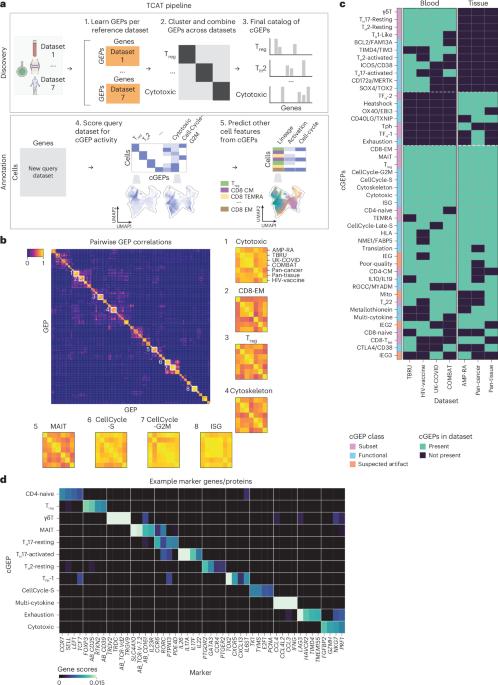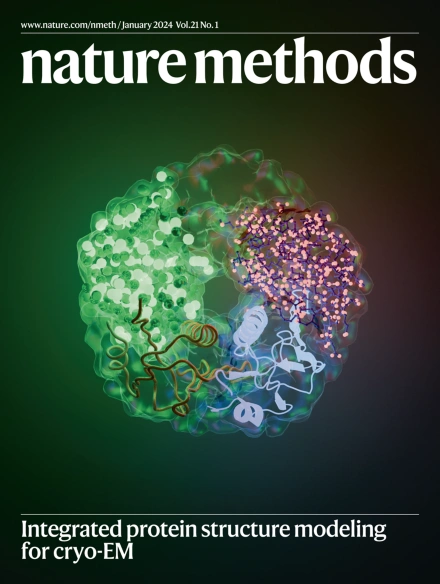T细胞亚群、激活状态和功能的可重复单细胞注释程序。
IF 32.1
1区 生物学
Q1 BIOCHEMICAL RESEARCH METHODS
引用次数: 0
摘要
T细胞识别抗原并诱导专门的基因表达程序(GEPs),从而实现增殖、细胞毒性和细胞因子产生等功能。传统上,不同的T细胞类别被认为表现出互斥的反应,包括TH1, TH2和TH17程序。然而,单细胞RNA测序揭示了连续的T细胞状态,没有明确的亚群,需要新的分析框架。在这里,我们介绍了T细胞注释器(TCAT),这是一个通过同时量化捕获激活状态和细胞子集的预定义gep来改进T细胞表征的管道。研究人员分析了来自700个人、38种组织和5种疾病背景的170万个T细胞,鉴定出46个可重复的gep,反映了T细胞的核心功能,包括增殖、细胞毒性、衰竭和效应状态。我们通过实验证明了新的激活程序,并应用TCAT来表征激活GEPs,预测多种肿瘤类型的免疫检查点抑制剂反应。我们的软件包starCAT概括了这个框架,使得在其他细胞类型和组织中可以重复注释。本文章由计算机程序翻译,如有差异,请以英文原文为准。

Reproducible single-cell annotation of programs underlying T cell subsets, activation states and functions
T cells recognize antigens and induce specialized gene expression programs (GEPs), enabling functions like proliferation, cytotoxicity and cytokine production. Traditionally, different T cell classes are thought to exhibit mutually exclusive responses, including TH1, TH2 and TH17 programs. However, single-cell RNA sequencing has revealed a continuum of T cell states without clearly distinct subsets, necessitating new analytical frameworks. Here, we introduce T-CellAnnoTator (TCAT), a pipeline that improves T cell characterization by simultaneously quantifying predefined GEPs capturing activation states and cellular subsets. Analyzing 1,700,000 T cells from 700 individuals spanning 38 tissues and five disease contexts, we identify 46 reproducible GEPs reflecting core T cell functions including proliferation, cytotoxicity, exhaustion and effector states. We experimentally demonstrate new activation programs and apply TCAT to characterize activation GEPs that predict immune checkpoint inhibitor response across multiple tumor types. Our software package starCAT generalizes this framework, enabling reproducible annotation in other cell types and tissues. TCAT is a pipeline that can simultaneously capture gene expression programs related to T cell subsets and activation states for accurate T cell characterization.
求助全文
通过发布文献求助,成功后即可免费获取论文全文。
去求助
来源期刊

Nature Methods
生物-生化研究方法
CiteScore
58.70
自引率
1.70%
发文量
326
审稿时长
1 months
期刊介绍:
Nature Methods is a monthly journal that focuses on publishing innovative methods and substantial enhancements to fundamental life sciences research techniques. Geared towards a diverse, interdisciplinary readership of researchers in academia and industry engaged in laboratory work, the journal offers new tools for research and emphasizes the immediate practical significance of the featured work. It publishes primary research papers and reviews recent technical and methodological advancements, with a particular interest in primary methods papers relevant to the biological and biomedical sciences. This includes methods rooted in chemistry with practical applications for studying biological problems.
 求助内容:
求助内容: 应助结果提醒方式:
应助结果提醒方式:


